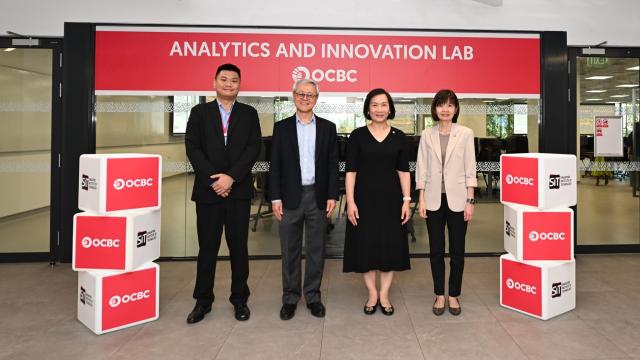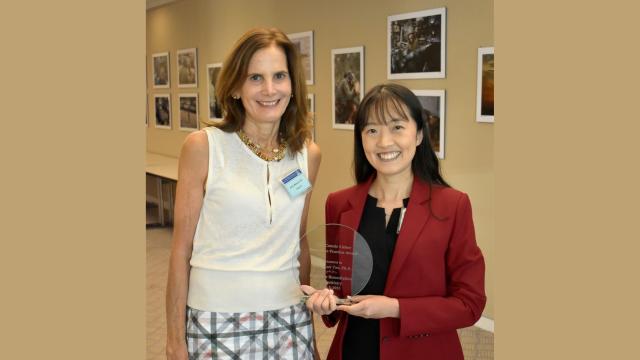Singapore Institute of Technology's (SIT) researchers are mixing up ways to minimise triboelectricity-induced fouling, a problem that has long plagued powdered food manufacturing.

A/Prof Wong Shin Yee (right) from SIT leads the research project on minimising triboelectricity-induced fouling, together with Research Engineer Ernest Lim Teng Shuen (left). (SIT Photo: Keng Photography/Tan Eng Keng)
The next time you make yourself a cup of 3-in-1 instant coffee, give the sachet a vigorous shake first. After pouring out your shaken coffee powder, you may notice that the tiny particles have begun to cling together, forming clumps in your cup or inside the packet itself. Like how a plastic comb can make your hair rise, agitated powdered particles can stick together due to a physically induced static electric charge, otherwise known as triboelectricity, and this affects more than just the coffee in your cup.
During manufacturing, the same phenomenon can cause powdered ingredients to stick together, leading to product buildup and eventually clogging machines. This problem, called fouling, results in disruptions and delays that cost food and bioproduct industries in the US an estimated US$7 billion annually.
To better understand why fouling happens and how to prevent it, researchers from the Singapore Institute of Technology (SIT) investigated the formulations of every household’s favourite 3-in-1 instant coffee powder. By investigating the cause of fouling as well as the electrostatic charge of each component, the researchers discovered the ideal mix to avoid potential fouling issues during scale-up or processing.
Figuring Out Fouling
“Food products tend to be formulated first for taste and nutrition before being scaled up for manufacturing, so manufacturing problems like fouling only surface late into the product development cycle,” explained lead researcher Associate Professor Wong Shin Yee of SIT’s Food, Chemical and Biotechnology cluster.
Accordingly, Wong and her team wanted to investigate if powder fouling could be alleviated before manufacturing occurs, taking these considerations into account even at the formulation stage. To do so, the team first visited industrial sites where they could observe the 3-in-1 instant coffee production process and determine what was causing the fouling.
“We observed that the ‘fouled’ powder could be easily brushed or tapped off the processing surfaces, indicating the absence of physical adhesion or chemical bonding,” Wong said. This observation strongly suggested that the powder adhesion that led to fouling was due to electrostatic attraction rather than chemical factors such as the powder solidifying or forming crystals, or biological factors like microbe growth and biofilm formation.
The team also noticed that fouling happened during the packaging stage. As the powder is channelled through narrow pathways to be dispensed into individual sachets, the physical contact and friction generates an electrostatic charge and leads to fouling.
The Perfect Formula
With the cause of fouling firmly established, the next step for Wong and her colleagues was to devise a way to reduce the chances of it happening in the first place.
When the researchers measured the electrostatic charge of different commercial 3-in-1 coffee mixes, they found that mixes with a high negative charge tended to foul more easily, with the ideal charge being neutral or zero.
Aware that changing the components and proportions in a powdered mix can also alter its electrostatic charge, Wong and her team analyzed each individual ingredient in the coffee mix to determine what formulation might bring 3-in-1 coffee to that ideal state.
They discovered that sugar with higher mineral levels generated less electrostatic charge when agitated and would therefore be less likely to foul. Meanwhile, coffee powders with lower caffeine levels and lower fat creamers generated less charge.
From this, the researchers proposed the ideal coffee mix formulation to reduce charge and therefore lower the risk of fouling.
“We recommend using sugar with high mineral content, coffee powder with low caffeine content, and creamers with low-fat content,” Wong shared.

Wong and her team discovered that reformulating powder mixes to neutralize the static charge can minimise the risk of powders clinging to stainless steel. (SIT Photo: Keng Photography/Tan Eng Keng)
Efficiency From The Get-Go
Despite establishing the correlation between powder formulation and electrostatic charge as well as the best formula for minimising fouling in 3-in-1 instant coffee, Wong acknowledged that taste remains the topmost concern when it comes to formulating food products.
Even so, she sees her study as “building layers of protection” right from the product formulation stage.
“Although we first started from a pain point during manufacturing, we discovered there was a unique way to approach the problem by mitigating the issue more easily during formulation,” she explained. “When it gets to production, manufacturers can then mitigate the charge further through other innovative means.”
Beyond tweaking the product formula, Wong’s research also highlights the potential advantages of revising the product development process as well.
“If you look at a typical new food product development cycle, there are usually two different groups of experts leading the formulation and the processing development separately,” Wong said. “From our study, it is clear that this should be a combined effort: formulate with processing constraints.”
Wong’s research, which illustrates the development of a holistic solution cycle to potentially solve a persistent industrial manufacturing problem, exemplifies SIT’s goal of using applied research to develop and translate solutions that are beneficial to the industry.
“We constantly reach out to industry partners to surface interesting issues that can present itself as opportunities for multiple layers of innovations and learning adventures,” Wong shared, adding that her findings are building the foundation of a food technology knowledge base.
Aligned with Singapore’s Research, Innovation and Enterprise 2020 strategy for Advanced Manufacturing and Engineering, Wong’s work is paving the way for boosting productivity in powder manufacturing, with the potential to expand further and help solve other issues in food powder handling.
“As an academic, I like to approach industrial problems as scientific adventures. All scientific adventures start with idea validation to establish whether the adventure is worth exploring,” Wong concluded. “I am very thankful to all who have worked on my blue-sky projects and their persistence in achieving scientific validations.”
---
Copyright: Asian Scientist Magazine; Photo: Singapore Institute of Technology.
This article first appeared in Asian Scientist Magazine online.
![[FA] SIT One SITizen Alumni Initiative_Web banner_1244px x 688px.jpg](/sites/default/files/2024-12/%5BFA%5D%20%20SIT%20One%20SITizen%20Alumni%20Initiative_Web%20banner_1244px%20x%20688px.jpg)


